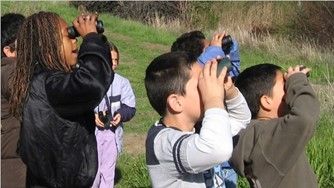Tuleyome’s Science Corner – Everything Plays a Part in the Ecosystem

Imagine you are 6 years old. You’ve just been handed a pair of binoculars and given instructions on how to use them. At first, when you place them against your eyes, everything goes blurry, but with a little help, you get them adjusted juuuust right… and now you can see everything! You’ve hiked for what seems like forever but you’ve seen so much cool stuff along the way, with the help of the binoculars. You’ve seen lots of different birds, insects, and you even spotted a bunny hopping past. Now the trail guide stops everyone right in front of this one gigantic tree and they want you to search the tree for signs of living things using your binoculars. There is so much to see! You and your friends inspect everything from the roots to the very tips of the branches and you discover there are living things on every inch of the tree! And not just the same living things. Worms and beetles live near the roots, insects and a squirrel crawl around on the trunk, and all sorts of different birds live throughout the branches, including a gigantic hawk (you know she lives there because her nest is there). After everyone shares what they found in the tree the group keeps hiking further and further and then, the trail guide stops at another tree. Only, this one is dead. Plus, it looks like it died a long time ago. It’s fallen over and broken and it looks like it's rotting in some places. The trail guide wants us to look for signs of living things again, but we aren’t going to find anything here. Are we?
Dead trees are an often overlooked part of the ecosystem, but they’re a large focus in one of our newest Tuleyome Adventures Education Program trails. Ecosystems are communities of living, interacting organisms and the habitat they live in. Living organisms in a community are reliant on each other but also on their habitat. They support each other as part of the food web and are provided resources such as nutrients, shelter, and water from the habitat. However, the habitat is just as reliant on the community members. If community members were to continuously drain their habitat of resources, without ever replenishing the supply, eventually the habitat would have nothing left to give, and the community members would suffer. An ecosystem tells the story of this intricate and balanced interaction, an interaction that operates as a cycle.
So how is a habitat replenished of all the nutrients it needs to support its community members? It happens through decomposition. When organic matter like a tree dies, it becomes another chapter in the ecosystem story. A new set of community members move in and take over this habitat- namely, decomposers. Looking carefully at a fallen tree you will probably first notice an array of gorgeous fungi and lichen. Carefully lift up a branch or broken piece of the trunk, and you are likely to find a host of critters crawling about underground- worms, pill bugs, beetles, and more. This special group of organisms are especially skilled at absorbing and consuming the dead organic material. In the process, they break down the complex molecules found in that material into more basic components like nitrogen, potassium, and phosphorus and return them to the soil.
As it happens, nitrogen, potassium, and phosphorus are just what plants need. Plants take in these nutrients through their roots along with the water, provided to them by the replenished Earth. The plants, as part of a complex food web system, go onto feed other members of the community, passing along the nutrients. Decomposers are key community members of this story, closing the cycle and returning resources to the habitat so the ecosystem can continue on and thrive.
Students adventuring on our new educational trails are sure to be entranced by all the wildlife and creatures they will encounter while out at the preserve. Observing with their binoculars and magnifying glasses will make them feel like real explorers. But their time on the trail is also a chance to understand more broadly what it means to be a part of the ecosystem. Afterall, as humans, we are community members as well, constantly affecting our habitat and requiring its resources. We are part of the ecosystem story. As we learn and educate about what it means to be a part of the ecosystem, we can think, too, about what we take and how we can give back to the Earth, our habitat and home.
More information about our new Tuleyome Adventures Education Program can be found on the field trips page of our website.
-Kara Green (kgreen@tuleyome.org)
Education Associate
RECENT ARTICLES






